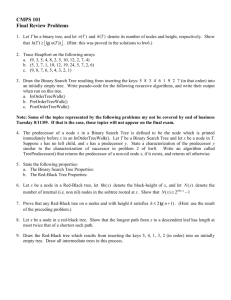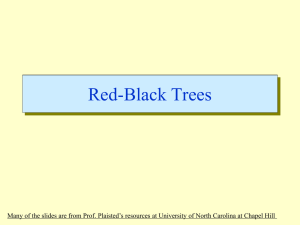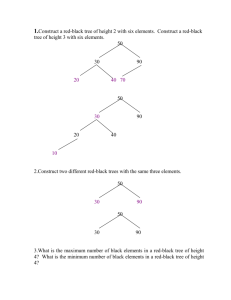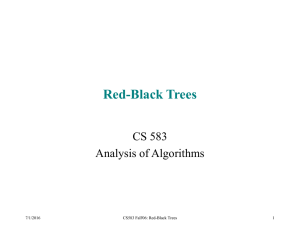Chapter13
advertisement
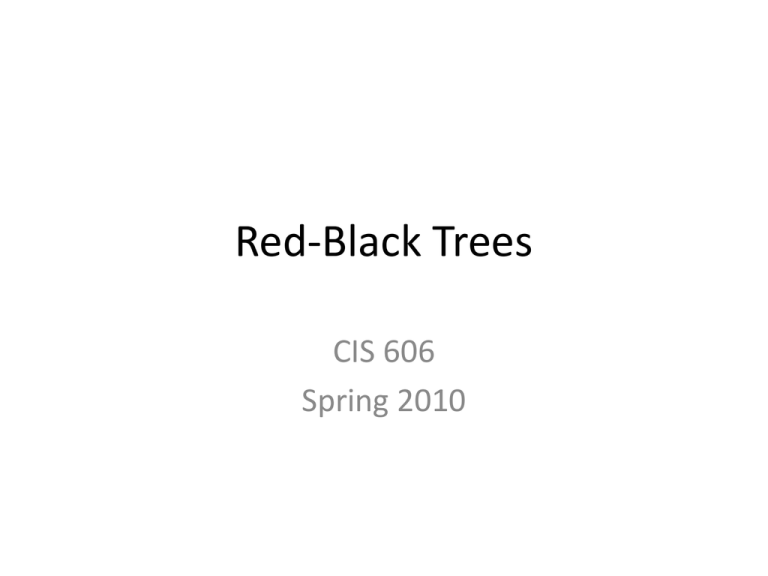
Red-Black Trees CIS 606 Spring 2010 Red-black trees • A variation of binary search trees. • Balanced: height is O(lg n), where n is the number of nodes. • Operations will take O(lg n) time in the worst case. Red-black trees • A red-black tree is a binary search tree + 1 bit per node: an attribute color, which is either red or black. • All leaves are empty (nil) and colored black. • We use a single sentinel, T.nil, for all the leaves of redblack tree T . • T.nil.color is black. • The root’s parent is also T.nil. • All other attributes of binary search trees are inherited by red-black trees (key, left,right, and p). We don’t care about the key in T.nil. Red-black properties 1. 2. 3. 4. Every node is either red or black. The root is black. Every leaf (T.nil) is black. If a node is red, then both its children are black. (Hence no two reds in a row on a simple path from the root to a leaf.) 5. For each node, all paths from the node to descendant leaves contain the same number of black nodes. Example Height of a red-black tree • Height of a node is the number of edges in a longest path to a leaf. • Black-height of a node x: bh(x) is the number of black nodes (including T.nil) on the path from x to leaf, not counting x. By property 5, black-height is well defined. Height of a red-black tree • Claim Any node with height h has black-height ≥ h/2. • Proof By property 4, ≤ h/2 nodes on the path from the node to a leaf are red. Hence ≥ h/2 are black. Height of a red-black tree • Claim The subtree rooted at any node x contains ≥ 2bh(x) - 1 internal nodes. • Proof By induction on height of x. • Basis: Height of x = 0 ⇒ x is a leaf ⇒ bh(x) = 0. The subtree rooted at x has 0 internal nodes. 20 - 1 = 0. • Inductive step: Let the height of x be h and bh(x) = b. Any child of x has height h - 1 and black-height either b (if the child is red) or b -1 (if the child is black). By the inductive hypothesis, each child has ≥ 2bh(x) - 1 - 1 internal nodes. Thus, the subtree rooted at x contains ≥ 2 ∙ (2bh(x) - 1 - 1) + 1 internal nodes. (The +1 is for x itself.) Height of a red-black tree • Lemma • A red-black tree with n internal nodes has height ≤ 2 lg(n + 1). • Proof Let h and b be the height and blackheight of the root, respectively. By the above two claims, n ≥ 2b - 1 ≥ 2h/2 – 1. • Adding 1 to both sides and then taking logs gives lg(n + 1) ≥ h/2, which implies that h ≤ 2 lg(n +1). Operations on red-black trees • The non-modifying binary-search-tree operations MINIMUM, MAXIMUM, SUCCESSOR, PREDECESSOR, and SEARCH run in O(height) time. Thus, they take O(lg n) time on red-black trees. • Insertion and deletion are not so easy. • If we insert, what color to make the new node? – Red? Might violate property 4. – Black? Might violate property 5. • If we delete, thus removing a node, what color was the node that was removed? – Red? OK, since we won’t have changed any black-heights, nor will we have created two red nodes in a row. Also, cannot cause a violation of property 2, since if the removed node was red, it could not have been the root. – Black? Could cause there to be two reds in a row (violating property 4), and can also cause a violation of property 5. Could also cause a violation of property 2, if the removed node was the root and its child — which becomes the new root — was red. Rotations • The basic tree-restructuring operation. • Needed to maintain red-black trees as balanced binary search trees. • Changes the local pointer structure. (Only pointers are changed.) • Won’t upset the binary-search-tree property. • Have both left rotation and right rotation. They are inverses of each other. • A rotation takes a red-black-tree and a node within the tree Rotations Rotations • The pseudocode for LEFT-ROTATE assumes that – x.right ≠ T.nil, and – root’s parent is T.nil. • Pseudocode for RIGHT-ROTATE is symmetric: exchange left and right everywhere. Example Insertion Insertion • RB-INSERT ends by coloring the new node z red. – Then it calls RB-INSERT-FIXUP because we could have violated a red-black property. • Which property might be violated? 1. OK. 2. If z is the root, then there’s a violation. Otherwise, OK. 3. OK. 4. If z.p is red, there’s a violation: both z and z.p are red. 5. OK. Insertion Insertion • Loop invariant: • At the start of each iteration of the while loop, a. z is red. b. There is at most one red-black violation: – Property 2: z is a red root, or – Property 4: z and z.p are both red. Insertion • Initialization: We’ve already seen why the loop invariant holds initially. • Termination: The loop terminates because z.p is black. Hence, property 4 is OK. Only property 2 might be violated, and the last line fixes it. • Maintenance: We drop out when z is the root (since then z.p is the sentinel T.nil, which is black). When we start the loop body, the only violation is of property 4. • There are 6 cases, 3 of which are symmetric to the other 3. The cases are not mutually exclusive. We’ll consider cases in which z.p is a left child. • Let y be z’s uncle (z.p’s sibling). Loop invariant Loop invariant Loop invariant Analysis Deletion Deletion Deletion • Differences between RB-TRANSPLANT and TRANSPLANT: – RB-TRANSPLANT references the sentinel T.nil instead of NIL. – Assignment to v.p occurs even if v points to the sentinel. In fact, we exploit the ability to assign to v.p when v points to the sentinel. • RB-DELETE has almost twice as many lines as TREE-DELETE, but you can find each line of TREEDELETE within RB-DELETE (with NIL replaced by T.nil and calls to TRANSPLANT replaced by calls to RB-TRANSPLANT). Differences between RB-DELETE and TREE-DELETE • y is the node either removed from the tree (when z has fewer than 2 children) or moved within the tree (when z has 2 children). • Need to save y’s original color (in y-original-color) to test it at the end, because if it’s black, then removing or moving y could cause red-black properties to be violated. • x is the node that moves into y’s original position. It’s either y’s only child, or T.nil if y has no children. • Sets x.p to point to the original position of y’s parent, even if x = T.nil. x.p is set in one of two ways: • If z is not y’s original parent, x.p is set in the last line of RB-TRANSPLANT. • If z is y’s original parent, then y will move up to take z’s position in the tree. The assignment x.p = y makes x.p point to the original position of y’s parent, even if x is T.nil. • If y’s original color was black, the changes to the tree structure might cause red-black properties to be violated, and we call RB-DELETE-FIXUP at the end to resolve the violations. Differences between RB-DELETE and TREE-DELETE • If y was originally black, what violations of red-black properties could arise? 1. No violation. 2. If y is the root and x is red, then the root has become red. 3. No violation. 4. Violation if x.p and x are both red. 5. Any simple path containing y now has 1 fewer black node. – Correct by giving x an “extra black.” – Add 1 to count of black nodes on paths containing x. – Now property 5 is OK, but property 1 is not. • x is either doubly black (if x.color = BLACK) or red & black (if x.color = RED) The attribute x.color is still either RED or BLACK. No new values for color attribute. In other words, the extra blackness on a node is by virtue of x pointing to the node. • ! • ! Remove the violations by calling RBDELETE-FIXUP: Idea • Move the extra black up the tree until – x points to a red & black node ⇒ turn it into a black node, – x points to the root ⇒ just remove the extra black, or – we can do certain rotations and recolorings and finish. • Within the while loop: – x always points to a nonroot doubly black node. – w is x’s sibling. – w cannot be T.nil, since that would violate property 5 at x.p. • There are 8 cases, 4 of which are symmetric to the other 4. As with insertion, the cases are not mutually exclusive. We’ll look at cases in which x is a left child. Case 1 Case 2 Case 3 Case 4 Analysis • O(lg n) time to get through RB-DELETE up to the call of RB-DELETE-FIXUP. • Within RB-DELETE-FIXUP: – – – – Case 2 is the only case in which more iterations occur. x moves up 1 level. Hence, O(lg n) iterations. Each of cases 1, 3, and 4 has 1 rotation ⇒ ≤ 3 rotations in all. – Hence, O(lg n) time.
